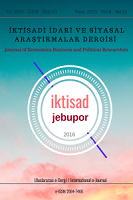Yapısal Kırılmalar Altında Finansal Yakınsama Hipotezinin Geçerliliğine Yönelik Ampirik Kanıtlar
Empirical Evidence for The Validity of The Financial Convergence Hypothesis Under Structural Breaks
Author(s): Soner Künç, Süleyman Çelik, Seyhun TutgunSubject(s): National Economy, Economic development, Financial Markets
Published by: Haci Mustafa Paksoy
Keywords: Convergence; Financial Development; BRICS Countries; Türkiye;
Summary/Abstract: Convergence hypotheses can be empirically tested on a variety of macroeconomic variable thanks to the advancement of economic and statistical theories. In recent years, the validity of the convergence hypothesis has been started to be analyzed for the financial systems as well as the interest rate, exchange rate, unemployment rate indicators of the countries. The aim of this study is to analyze how the financial development levels of Brazil, Russia, India, China, South Africa and Turkey, which are expressed as BRICS-T, converge to the USA, which is considered as the dominant country in the field of finance. Structural break unit root tests for the BRICS-T countries were conducted to evaluate the validity of the theory. Brazil demonstrated financial concerns after 2000, despite convergence and divergence occurring up until 1998 between 1984 and 2020. Russia separated till the 2000s before returning to the convergence trend after 2010 despite having had a major break in the 1990s. Up until the 2000s, Turkey, China, South Africa, and India generally adopted different paths, but it is clear that financial convergence started to happen following that year. Overall, it was determined that all of the BRICS-T nations began to experience convergence after the 2000s, but at varying rates.
Journal: İktisadi İdari ve Siyasal Araştırmalar Dergisi (İKTİSAD)
- Issue Year: 8/2023
- Issue No: 21
- Page Range: 584-599
- Page Count: 16
- Language: Turkish

